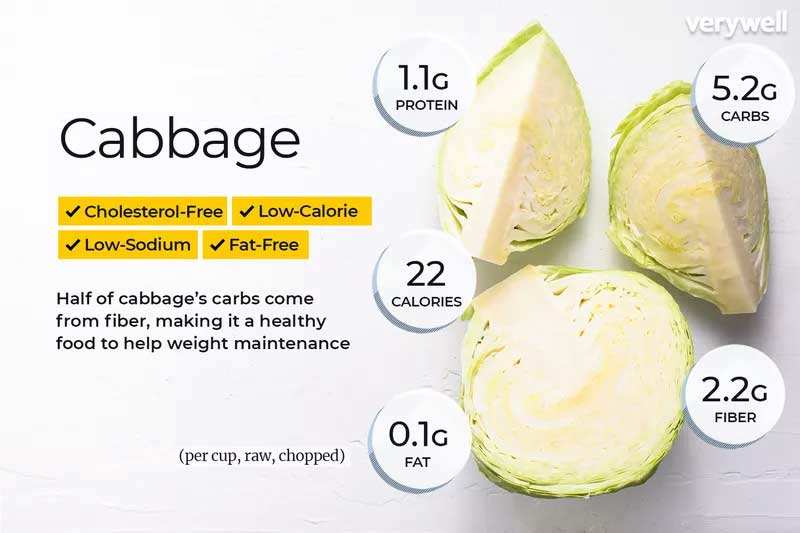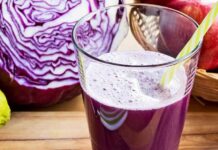
Cabbage is often associated with the infamous cabbage soup diet, but this crisp, inexpensive, and versatile veggie can be used in a wide range of recipes and can add crunch and color to salads and sandwiches. Cabbage provides fiber and other nutrients like potassium and vitamin K, making it a great complement to a healthy lifestyle.
Cabbage Nutrition Facts
One cup of raw, chopped cabbage (89g) provides 22 calories, 1.1g of protein, 5.2g of carbohydrates, and 0.1g of fat. Cabbage also provides potassium, folate, and vitamin K. This nutrition information is provided by the USDA.1
- Calories: 22
- Fat: 0.1g
- Sodium: 16mg
- Carbohydrates: 5.2g
- Fiber: 2.2g
- Sugars: 2.9g
- Protein: 1.1g
- Potassium: 151mg
- Folate: 38.3mcg
- Vitamin K: 67.6mcg
Carbs
A cup of raw cabbage has just over 5 grams of carbohydrate, with about 50% coming from fiber and 50% from natural sugars. Cabbage has a very low glycemic index of 10.2
Fats
Cabbage is basically a fat-free food. There is less than one gram in a single one-cup serving.
Protein
There’s 1 gram of protein in a cup of raw cabbage. Cabbage is not a significant protein source.
Vitamins and Minerals
Cabbage is a good source of potassium, folate, and vitamin K. Cabbage also provides some calcium, iron, vitamin A, and vitamin C.
Calories
Cabbage is a low-calorie food, providing just 22 calories per cup, chopped.
Summary
Cabbage is a low-calorie, nearly fat-free food that is a good source of potassium, folate, and vitamin K. It provides fiber but is not a significant source of protein.
Health Benefits
Cabbage is a nutritious vegetable that can boost your body’s natural defenses against disease. Here are some areas where cabbage is especially helpful.
Promotes Cardiovascular Health
Cabbage is a good source of fiber and potassium, two key nutrients for heart health. While fiber helps bring down cholesterol levels,3 potassium lowers blood pressure.4 Furthermore, cabbage is a good source of the B vitamin, folate. Higher intakes of folate are linked to a lower risk of stroke and heart attack.5
Supports Brain Health
The Academy of Nutrition and Dietetics recommends cabbage and other cruciferous vegetables to help maintain strong cognitive function with age.6 Memory and alertness levels can be improved with good nutrition. The nutrients in cabbage help optimize blood flow to the brain. Cabbage is beneficial for people of all ages who want to stay sharp.
May Lower Cancer Risk
Cabbage also contains anti-cancer properties. Studies suggest that getting three to five weekly servings of cruciferous veggies (such as cabbage, cauliflower, broccoli, Brussels sprouts, kale, and collard greens) protects against several types of cancer. Prostate, lung, breast, and colon cancer risks are reduced, likely due to compounds in cruciferous veggies that activate enzymes in the liver and bind carcinogens.7
Protects Vision
The color of red or purple cabbage is due to a high content of polyphenols, including anthocyanins. These antioxidants work throughout the body to prevent oxidative damage associated with a host of health issues, including blindness caused by age-related macular degeneration. Cabbage is a good source of lutein and zeaxanthin, forms of vitamin A that are known to accumulate in the retina and be especially helpful for warding off vision damage.8
Improves Glucose Control
For people with diabetes, cruciferous vegetables like cabbage are an excellent choice.9 Cabbage is a nonstarchy veggie that’s low in carbohydrates and high in fiber. The fiber in cabbage keeps blood sugars stable, preventing dangerous highs and lows.
Cabbage can be substituted for some refined-flour foods to keep your carb count down. By using cabbage wraps instead of flour tortillas, for instance, you can reduce added carbs while boosting the micronutrient content of your meal.
Allergies
Cabbage allergies are rare but possible. Typical food allergy symptoms include hives, vomiting, dizziness, or tongue swelling. In severe cases, anaphylaxis, a life-threatening reaction, can also occur.
Cabbage may also cross-react with mugwort allergies in a condition called oral allergy syndrome.10 People with a mugwort allergy can be triggered after eating cabbage. If you suspect an allergy to cabbage, or oral allergy syndrome, see an allergist for a full evaluation.
Adverse Effects
Cabbage is high in vitamin K and may interact with the blood thinner Coumadin (warfarin).11 If you take blood thinners, your doctor may advise you to maintain a consistent intake of foods that are high in vitamin K to prevent fluctuations in medication effectiveness.
Cabbage is also high in fiber that can be difficult to digest if your body isn’t used to it. To minimize digestive discomfort, increase your intake of cabbage gradually and give your body time to adjust.
Varieties
Cabbage comes in several varieties. Some green cabbage varieties include Cheers, Early Jersey Wakefield, and King Cole. Savory cabbages like Savory King and Savory Queen have crinkly leaves and are less common. Red cabbage varieties, such as Red Meteor and Ruby Ball, are growing popularity.12 The nutrition facts for red cabbage are very similar to that of green cabbage.
When It’s Best
Most cabbage is available year-round in the grocery store or farmer’s markets. Look for large cabbage heads that are intact (not split). Cabbages should be tight, heavy for their size, and free of insects and decay.12
Storage and Food Safety
Fresh cabbage is hardy and can be stored in the refrigerator for up to two weeks (savory cabbage varieties are best used within four days). In conditions under 32 degrees Fahrenheit with 95% relative humidity, cabbage may keep for as long as 5 months. Cabbage can also be pickled or fermented for home preservation.13
How to Prepare
Wait to wash cabbage until you’re ready to use it. Rinse cabbage leaves well under running water before cutting or eating. Remove the core and any decayed outer leaves before preparing cabbage.
If you’re steaming or sautéing cabbage, you might notice an unpleasant smell. This is because of the sulfur compounds in cabbage that are activated during the heating process. To minimize the smell, avoid using aluminum cookware. Try splashing with a bit of acid, like lemon juice, to inhibit the activation.
Preparing red cabbage with stainless steel knives and cookware will prevent color changes. To keep red cabbage from turning blue or grey, cook with an acidic ingredient like vinegar.12
Cabbage may be consumed raw and shredded as in coleslaw, or used in soups and stews. Chop cabbage up and add to stir-fry dishes. You can also steam the leaves and use them as a wrap for meat or other fillings. Ferment cabbage to make your own sauerkraut.
Sources:
- Cabbage, raw. FoodData Central. U.S. Department of Agriculture.
- NWAC diabetes self-management toolkit for Aboriginal women – fact sheet: Glycemic index. Native Women’s Association of Canada.
- Soliman GA. Dietary fiber, atherosclerosis, and cardiovascular disease. Nutrients. 2019;11(5):1155. doi:10.3390/nu11051155
- Houston MC. The importance of potassium in managing hypertensioCurr Hypertens Rep. 2011;13(4):309-17. doi:10.1007/s11906-011-0197-8.
- Huo Y, Li J, Qin X, et al. Efficacy of folic acid therapy in primary prevention of stroke among adults with hypertension in China: the CSPPT randomized clinical trial. JAMA. 2015;313(13):1325. doi:10.1001/jama.2015.2274
- Moore M. 4 types of foods to support memory. Academy of Nutrition and Dietetics.
- Nosrati N, Bakovic M, Paliyath G. Molecular mechanisms and pathways as targets for cancer prevention and progression with dietary compounds. Int J Mol Sci. 2017;18(10):2050. doi:10.3390/ijms18102050
- National Institutes of Health Office of Dietary Supplements. Vitamin A: Fact sheet for health professionals.
- The top 10 worst foods if you have diabetes. Cleveland Clinic.
- Oral allergy syndrome (OAS) or pollen fruit syndrome (PFS). American Academy of Allergy, Asthma & Immunology.
- Violi F, Lip GY, Pignatelli P, Pastori D. Interaction between dietary vitamin K intake and anticoagulation by vitamin K antagonists: Is it really true?: A systematic review. Medicine (Baltimore). 2016;95(10):e2895. doi:10.1097/MD.0000000000002895
- Cabbage. University of Illinois Extension, Watch Your Garden Grow.
- Cabbage. University of Maryland Extension.
Important Notice: This article was originally published at www.verywellfit.com by Barbie Cervoni MS, RD, CDCES, CDN where all credits are due. Medically reviewed by Marisa Moore, RDN, MBA
Disclaimer
The watching, interacting, and participation of any kind with anything on this page does not constitute or initiate a doctor-patient relationship with Dr. Farrah®. None of the statements here have been evaluated by the Food and Drug Administration (FDA). The products of Dr. Farrah® are not intended to diagnose, treat, cure, or prevent any disease. The information being provided should only be considered for education and entertainment purposes only. If you feel that anything you see or hear may be of value to you on this page or on any other medium of any kind associated with, showing, or quoting anything relating to Dr. Farrah® in any way at any time, you are encouraged to and agree to consult with a licensed healthcare professional in your area to discuss it. If you feel that you’re having a healthcare emergency, seek medical attention immediately. The views expressed here are simply either the views and opinions of Dr. Farrah® or others appearing and are protected under the first amendment.
Dr. Farrah® is a highly experienced Licensed Medical Doctor certified in evidence-based clinical nutrition, not some enthusiast, formulator, or medium promoting the wild and unrestrained use of nutrition products for health issues without clinical experience and scientific evidence of therapeutic benefit. Dr. Farrah® has personally and keenly studied everything she recommends, and more importantly, she’s closely observed the reactions and results in a clinical setting countless times over the course of her career involving the treatment of over 150,000 patients.
Dr. Farrah® promotes evidence-based natural approaches to health, which means integrating her individual scientific and clinical expertise with the best available external clinical evidence from systematic research. By individual clinical expertise, I refer to the proficiency and judgment that individual clinicians acquire through clinical experience and clinical practice.
Dr. Farrah® does not make any representation or warranties with respect to the accuracy, applicability, fitness, or completeness of any multimedia content provided. Dr. Farrah® does not warrant the performance, effectiveness, or applicability of any sites listed, linked, or referenced to, in, or by any multimedia content.
To be clear, the multimedia content is not intended to be a substitute for professional medical advice, diagnosis, or treatment. Always seek the advice of your physician or other qualified health providers with any questions you may have regarding a medical condition. Never disregard professional medical advice or delay in seeking it because of something you have read or seen in any website, video, image, or media of any kind. Dr. Farrah® hereby disclaims any and all liability to any party for any direct, indirect, implied, punitive, special, incidental, or other consequential damages arising directly or indirectly from any use of the content, which is provided as is, and without warranties.








